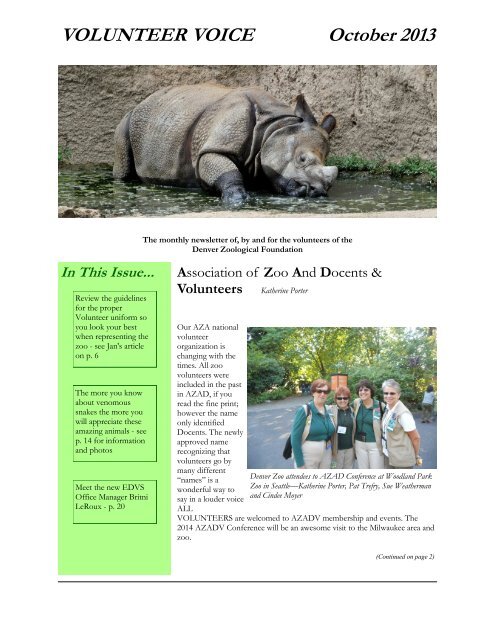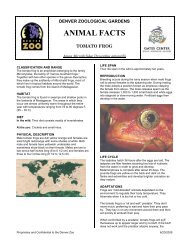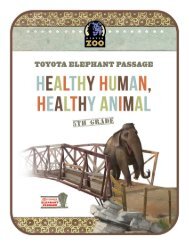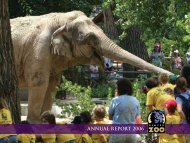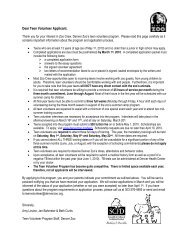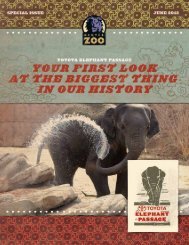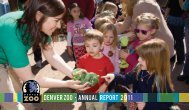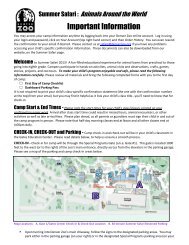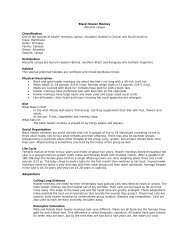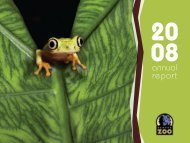VOLUNTEER VOICE October 2013 In This Issue... - Denver Zoo
VOLUNTEER VOICE October 2013 In This Issue... - Denver Zoo
VOLUNTEER VOICE October 2013 In This Issue... - Denver Zoo
You also want an ePaper? Increase the reach of your titles
YUMPU automatically turns print PDFs into web optimized ePapers that Google loves.
Volunteer VoiceJan’s CornerJan Waterman, Adult Volunteer Program Specialistjwaterman@denverzoo.orgThe Autumnal Equinox or the official start to Fall was September 22. Here are some things you’ll need to knowfor the upcoming months:Hour Changes:Daylight Savings time ends Sunday, November 3 – set your clocks back one hour Saturday night!Winter hours start on November 1st. The gate opens at 10:00 a.m. and closes at 4:00 p.m.. Visitors mayremain on grounds until 5:00 p.m.During <strong>Zoo</strong> Lights, Security does a complete sweep of the zoo making sure all of our daytime guestshave departed before opening for <strong>Zoo</strong> Lights at 6:00 p.m.Winter Admission Price Changes November 1, <strong>2013</strong> – February 28, 2014: Ages 12 – 64 $12.00 Ages 65+ $10.00 Ages 3 – 11 $8.00 2 and under FREELooking for more hours? Here are some dates and events coming up in the next couple of months:Lorikeet Adventure:Open every day through mid-November, weather permitting10:00 a.m. – 1:00 p.m.1:00 p.m. – 4:00 p.m.Requires Lorikeet Adventure CE and TB TestingMain Gate Ambassador:<strong>October</strong> Shifts: 9:00 – 12:00 12:00 – 3:30Winter Shifts: 10:00 – 2:00Shoulder Month Weekends:There are Guide Stations and Ask Me’s posted on all weekends through <strong>October</strong> before Boo at the <strong>Zoo</strong>.(Continued on page 7)Page 6
Volunteer Voice(Continued from page 6)Boo at the <strong>Zoo</strong>:Boo after Dark – Friday, <strong>October</strong> 25 6:30 p.m. – 9:00 p.m.Boo at the <strong>Zoo</strong> – Saturday and Sunday, <strong>October</strong> 26 & 27 9:00 a.m. – 5:00 p.m.Festival of the Animals:Look for weekday postings for this event coming up the first two weeks in November. Details will also be inthe <strong>Zoo</strong> Scoop.Veterans Day:Monday, November 11 – postings are still TBD, but we’ll let you know details very soon.Free Days:We have three coming up in November. These are some of the best days that can be spent here at our zoo.Studies show that our visitors on Free Days want and expect more education opportunities, demos, andinteractions with staff and volunteers more than our daily visitors do. And you will never receive more “thankyou’s” for what you do than on our Free Days! Monday, November 4 Friday, November 15 Thursday, November 21Clothing Options:All clothing should be kept in presentable condition; clothing with tears, holes or stains should be replaced, andplease select clothing that fits you appropriately. Shirts do not need to be tucked in, so long as the volunteer ispresentable.You may wear your green or white polo’s year ‘round – long sleeved polo’s are available for purchasefrom us, but only in white. Fall is a good time to find our zoo “green” color in the stores. I found themonline at Target, Sears and JC Penney’s in short and long-sleeved versions. You can purchase them andbring them into us to have a patch sewn on for $5.00.Vests are optional year round – unless your shirt does not have an official <strong>Denver</strong> <strong>Zoo</strong> logo. If yourshirt does not have <strong>Denver</strong> <strong>Zoo</strong> logo, you must wear your vest over it. You may order a vest any time or– if you don’t have a Volunteer Vest, you can always borrow one from the closet in the VolunteerCenter. We have a variety of sizes.Other fall/winter items that you can purchase from us include our sweatshirts, hoodies, and zipperedhoodies. We also have that great fleece vest and two weights of jackets.If you choose to wear your own jacket, we just ask that it be a neutral solid color – no stripes orpatterns. It also shouldn’t have any logo on it. You can always purchase our outwear badge to wear onyour coats or jackets for only $5.00. And remember that the outwear badge is only for outwear and isnot to be worn on any of your shirts or Volunteer Vests.(Continued on page 8)Page 7
Volunteer Voice(Continued from page 7)Other general guidelines:Khaki skirts, shorts or pantsHats with no logo or with the zoo’s logoName Badge – visible at all timesComfortable shoesMinimal jewelryFall is my favorite season. The zoo is particularly beautiful, our animals arevery active and it’s just a great time of year to be here. I hope to see manyof you here enjoying these bright, crisp days!Page 8
Volunteer VoiceLiaison Team UpdatesHeidi Lumberg, Public Programs Specialist720-337-1613 hlumberg@denverzoo.orgZOO PRESENTERS <strong>2013</strong>: IT WAS A VERY GOOD YEAR!Another summer has come and gone, and with itanother very successful season for the <strong>Zoo</strong>Presenter volunteer program! <strong>This</strong> summer wehad 165 volunteers—Ambassadors, Guides, andDocents—contributing just over 8,115 hoursengaging zoo guests at the Wildlife Show, LorikeetAdventure, Guide stations, Visitor ResourcePresenter kiosks, Meet the Animal Stars, Ask Me'sin Toyota Elephant Passage, and WildEncounters!<strong>This</strong> year we piloted a brand new <strong>Zoo</strong> Presenteractivity—Visitor Resource Presenters. Volunteerswere stationed at information kiosks nearConoco/old pachys and Giraffe Meadow, armedwith all the resources necessary to answer guest VRP—Giraffes (Gretchen Koplin)questions and make their visit as rewarding aspossible. One of the outcomes we intended for guests after interacting with oneof these volunteers was that they would take advantage of more shows anddemos, since we could help them plan their visit accordingly. The large crowdsobserved at the Wildlife Show, Animal Giants demonstrations, sea lion shows,etc.; tell me we did a great job achieving that goal. Many Visitor ResourcePresenters themselves reflected on positive guest interactions and expressed realsatisfaction in helping to better connect our visitors with our fantastic facility andanimal collection. And with so many new babies this summer, there was alwayssomething fun to bring to the visitors’ attention! <strong>This</strong> is a volunteer opportunitythat we intend to continue to offer in the fall on busy weekends and Free Days,and will likely continue next year.Another new venture this summer was pairing a teen and an adult volunteer atone of our Guide stations, “An Enriched Home is a Happy Home.” Our hopewas that these partnerships would be mutually rewarding and provide a freshperspective on how we interpret a Guide station. Approximately 345 hours werespent in these partnerships this summer! Our adult volunteers were tremendouslyimpressed with the amount of interpretive training and knowledge that our teensbrought to the table, and the teens undoubtedly picked up valuable skills fromVRP—Conoco Pavilions (CarrieWinter)(Continued on page 10)Page 9
Volunteer Voice(Continued from page 9)the adults to add to their interpretivetoolboxes. With the success of this approachthis summer, you can look forward to moresuch joint ventures in the future!The new Wildlife Show this summer made theWildlife Show Assistant job more fun thanever, with its highly interactive approach andgreat new routines for our charismatic critters.Even volunteers who saw the show numeroustimes always found something new toappreciate and enjoy while making sure theguests had the best possible experience.I am always impressed by the dedication of thevolunteers who make the commitment to the<strong>Zoo</strong> Presenters program and this year was no Nicole Egtvedt and Ken Flesnerexception. <strong>In</strong> fact, I think this was one of theliveliest, most upbeat, and just plain fun seasons in recent memory. The smiles, laughter, camaraderie, andsupport that the volunteers shared with one another and our visitors made me look forward to coming to the zooeach day and feel proud to be a part of this program. Please check the <strong>Zoo</strong> Presenters wall in the VolunteerCenter to see some great photos of the summer fun, courtesy of Sarah Parish and Julianne Waddell!It won’t be long before it’s time to sign up for <strong>Zoo</strong> Presenters 2014. I’ll be coming to a General Meeting near youto tell you about all the great things we’ll be cooking up for next season. If you don’t know about thistremendous program or have questions, please feel free to ask me at any time. I never get tired of talking about it!Crossing hurdles at the Wildlife ShowPage 10
Volunteer VoiceTeen ProgramsJennifer Bahmeier HendersonJBahmeier@denverzoo.orgPictures courtesy of Jennifer Bahmeier HendersonSUMMER <strong>2013</strong> LIAISON REPORT TEENPROGRAMSWow, what happened to the summer? Suddenly it isquite quiet around the Volunteer Center and out ongrounds, as the teens have migrated back into theirclassrooms, <strong>Zoo</strong> Presenters is over, and the publicnumbers start to get smaller during the week. As we allget ready for the beautiful Colorado fall, each year Ithink to myself how much I love the cyclical nature ofthe zoo. I also feel so lucky as I think about the impactthat we each have on the guest experience, especially inthe summer with the thousands of guest that walkthrough the gates….that is pretty incredible to thinkabout.The <strong>Zoo</strong> Crew program has grown in opportunities Jifu Groleau with sand boaover the last couple of years, adding a few new jobs butstaying fairly consistent in the number of teens that we have in the program. <strong>This</strong> has been intentional as we wantto ensure that that we retain a good balance of support and opportunity. Summer <strong>2013</strong> we had 109 teens servingin <strong>Zoo</strong> Crew, and we now have teens working in over 30 different roles in various departments from Education,Animal and even in the Planning department!On any given day duringJune, July and thebeginning of August, 45teens were here during theweek, and the excitementoverflowed! <strong>This</strong> summer,teens experienced 165revamped “morninghuddles” that occurred inthe Volunteer Center,outside, and sometimes inthe hallways. Each weekhad a theme. We arethankful to the numerousvolunteers that gave somereally engaging talks to ourKate Berreman and Dave SassmanMariah Garrison and Jess Bertram(Continued on page 12)Page 11
Volunteer Voice(Continued from page 11)teens this summer and acted as guest speakers. <strong>In</strong> June, eight adult volunteers shared stories of <strong>Denver</strong> <strong>Zoo</strong>animals and/or exhibits with the teens, two of these contributors being our very own Teen Advocates JohnSkaradowski and Mary Rosenburger.The nine Teen Advocates (T.A.) have an integral role in the program, and this summer we have continued torefine how we schedule and define the Teen Advocate role. Teen Advocates are now primary mentoring contactsfor all of the new teens, and this summer they self scheduled two coaching sessions (one at the beginning, andone at the end) of the summer with each of “their” new teens. <strong>In</strong> total, T.A.’s ran 50 coaching sessions with newteens this summer, partnered with teens at interpretive stations like Trumpeting Trunks and Tackle the Tundrafor a total of 178 hours and also helped to deliver trainings. Training assistance was a new component this year,Teen Advocates ran the <strong>In</strong>terpretive portion of summer training that occurred as a part of our popular CampOut experiences. Dave Sassman, Katie Barbier, John Skaradowski, and Jess Bertram all contributed to these campout trainings, resulting in 10 total hours.Many of you know that our program focuses on careerexposure and professional readiness for our <strong>Zoo</strong> Crewteens. <strong>2013</strong> brought the second year of teens being ableto contribute to conservation field work at Rio Mora.Not only did teens learn field skills but on a biggerpicture these experiences are designed to help teenslearn what it is really like to work in the field so they aremore informed when they make bigger life decisions asthey approach graduation. We again took three tripsover the summer, ranging in length from four to fivedays. <strong>This</strong> year was even more successful as weexpanded the reflection activities as well as serviceopportunities when at the ranch. Eighteen teens in totalparticipated, and Jen shared the program in a posterformat at the Association of <strong>Zoo</strong>s and Aquariumsconference in Sept. Many other sister institutions wereinterested in the model that <strong>Denver</strong> <strong>Zoo</strong> welcomesstaff, adult, and teen volunteers to contribute toconservation research. It was a very proud moment torealize that this opportunity will be used as a successfulexample as other contemporaries look at opportunitiesfor Volunteers.From the <strong>Zoo</strong> Presenter and <strong>Zoo</strong> Crew partneringfront, teens and adults partnered at “An EnrichedHome is a Happy Home” for a total of 350 hours.Recently two of our teen volunteers Kira Fish and<strong>In</strong>stallation day of Lady Phant (starting from the back row)Hanna and Jen – (second row) Nick Kreutzer, Lauren Hitt,Kira Fish, Kaitlyn Lupinetti, Lauren Tidemann (front row)Lindsay Hoylman, Randall Kaemingk, Samantha Cathey atTeen <strong>In</strong>terpretive Station—TEP Artistic AsiaAlaina Kuehr presented with our Teen Liaison, Jess Bertram in guide training to welcome new guides to theopportunity of partnering with a teen volunteer at this station. We will continue to look at feedback to knowhow it worked out from everyone’s perspective.Speaking of <strong>In</strong>terpretive Stations, Summer <strong>2013</strong> brought an exciting new addition to <strong>Denver</strong> <strong>Zoo</strong> in the form ofa new Teen <strong>In</strong>terpretive Station located in TEP, "Artistic Asia". Lady (Ele) ‘Phant, a 6 feet tall and 10 feet wide(Continued on page 13)Page 12
Volunteer Voice(Continued from page 12)public art piece debuted as a part of this station in July, and was mounted on the south wall of the Village Hallbuilding behind the station. Teens led zoo guests through the creation of paper folded animals; additionally,guests could choose to make a wish for animals and leave their paper animal if they wanted it be incorporatedinto the collective art piece. The paper folded animals were threaded onto pre-attached metal wire to allow thesculpture to transform throughout the summer. The station was designed to highlight the ways in which animalsare celebrated in different Asian cultures through art, and allow <strong>Denver</strong> <strong>Zoo</strong> guests to contribute directly topublic art at <strong>Denver</strong> <strong>Zoo</strong>. A total of 97 teen volunteers worked at the station this summer, for a total of 701volunteer hours!Summer <strong>2013</strong> also brought some exciting transitions for our staff. At the end of the summer we wished two longtime staff and former <strong>Zoo</strong> Crew teen volunteers well as they both took jumps forward into new adventures. Anaand Eric both left Teen Programs in August, and we are so proud of both of them as they left to pursue theirdream careers. With that change came an exciting new opportunity, after interviewing our top candidates, wewere happy that our very own seasonal of two years rose to the top of this very competitive pool, and acceptedthe Teen Programs Specialist position. Hanna Hopkins started in this role on September 9 th , and is sitting in thedesk near Jan. We are so excited to have her on board!Summer wrapped up with a Teen Advocate get-together organized by Jess Bertram. Although we had a smallerturnout then we hoped, we were thankful to close the summer together and recognize the contributions of allinvolved. Teen Advocate hours total 224 this summer, and our grand hours total for Teen Volunteers in Summer<strong>2013</strong> is 13,725! Whoo-hoo!Page 13
Volunteer VoiceAround the <strong>Zoo</strong>Tropical DiscoveryRichard Gordon 303-756-7427RichardNGordon@comcast.netVENOMOUS SNAKESWhat is long, thin, beautiful, senses smell with its tongue, has many vertebrae and ribs, no external ears, can’tblink, moves by rectilinear, concertina, serpentine, or side winding motion, and raises fear in most humans?Snakes of course. <strong>In</strong> this article, we are going to limit our discussion to the care and protocols of the 28 species ofvenomous snakes on exhibit at <strong>Denver</strong> <strong>Zoo</strong>.Yes, the hair on many of our visitors necks stand on end when we bring up the subject of snakes, especiallyvenomous snakes. The more we know, the better equipped we will be to discuss snakes with the public, the morerespectful we will be of their true dangers, and the more comfortable we will be around them. <strong>Denver</strong> <strong>Zoo</strong>happens to have a remarkable, notable and exceptional collection of venomous snakes and an equally remarkablegroup of keepers who look after them.Our venomous snake lead keeper is Tim Trout whose degree is a Bachelors of Science in Chemistry andPsychology. He had kept snakes personally, which led him to an appreciation of them and especially venomoussnakes while also working with a private breeder prior to becoming a keeper at <strong>Denver</strong> <strong>Zoo</strong>. The keepers inTropical Discovery all have to be able to care for of the animals in their section of the building including cleaningthe exhibits, preparing diets, feeding the individual animals, taking care of each animal's special needs, knowingthe protocols for their care. And each new keeper must go through training and certification by the AssistantCurator Tom Weaver and each keeper gets recertified twice a year to handle and secure venomous snakes. Pleasenote that there has never been avenomous snakebite at <strong>Denver</strong> <strong>Zoo</strong>.However, the keepers need to knowwhat to do should there ever be one.There are some very unique species ofvenomous snakes in Tropical Discovery.The Mangshan viper was onlydiscovered about 20 years ago (firstwritten about in 1993) and little isknown about this species. They mightbe on the critically endangered specieslists if more were known about them.Look closely at them the next time youare in Tropical Discovery, they haveLouisiana pine snakeMangshan vipertruly beautiful markings and coloration. Although not venomous, the Louisiana pine snake is one of the rarestspecies in our collection and has a unique story (see the previous article on these interesting snakes). Of coursethe king cobra which is nearly 16 feet long, is popular with the public. <strong>This</strong> snake's markings subtly change overthe length of its body. Our king cobra is about 14 years old with a potential life span of over 20 years.(Continued on page 15)Page 14
Volunteer Voice(Continued from page 14)King cobraGreen mambaConsidered to be our most venomous snakes in no particular order are theking cobra because of its size and the amount of venom it can deliver; theSouth American rattlesnake (neo-tropical) has a very strong neurotoxicvenom that will kill a large rat in seven seconds. Mambas and the WestAfrican Gaboon viper’s venom are also considered very toxic.South American rattlesnake (neotropical)When a keeper is working in the venomous snake area, the first thing he/she must do is put a “HOT” tag by their name on the kitchen door. <strong>This</strong>lets all other keepers know that they are working in the area with venomousanimals. They know the behavior of the snakes they will be working around.When Tim works with venomous snakes that can be handled, he has specialtools he uses like a long hook, gloves, extra long tongs, and a special golfclub with a spoon on the end. The king cobra and the mambas are shiftedout of their exhibits when the exhibits are cleaned.Gaboon viperWe learned in <strong>Zoo</strong> U about the different codes that staff needs to respondto for escaped animals. There are also specific protocols should there ever be a venomous snakebite. When firstdiscovered, staff needs to press an alarm button, which is not only very loud, but will show on every alarm panelin the building exactly where the incident occurred. Each TD keeper knows their responsibilities in a biteemergency based on when they arrive at the bite location. On weekdays, two keepers will respond to the alarmand secure the snake, stabilize the victim and prepare for transport to <strong>Denver</strong> General (get a wheel chair andmove the victim to gate 4). Also phone administrative personnel, then either staff or admin will phone RickHaeffner, Tom Weaver, the CEO, the COO, and Security. They will also phone 911 and Rocky Mountain PoisonControl Center. Specific actions include first aid to the victim, making the necessary phone calls, opening gates ordoors, getting the wheel chair, meet the emergency vehicle at the front gate and take it to gate 4 where staff willhave brought the victim in a wheel chair for transport to <strong>Denver</strong> General with our antivenin. On weekends threekeepers are needed for the protocols (because there are fewer staff members on grounds), in order to meet theambulance at the front gate and take them to gate 4. It takes three to five minutes to get the victim to gate 4 andabout the same time for the ambulance to get there.There is an Antivenin <strong>In</strong>dex that all poison control centers have which lists all sources of antivenin and whatfacility has which antivenin and how much. <strong>This</strong> list of zoo inventories is almost exclusively used by poisoncontrol centers to treat private individuals, not to provide antivenin to zoos. We have a large supply of eightdifferent kinds of antivenin which can last up to three years from the date it is produced. Curator Rick Haeffnerreports that the average cost per year to maintain our supply over the last three years has been $12,350.00.(Continued on page 16)Page 15
Volunteer Voice(Continued from page 15)<strong>Denver</strong> <strong>Zoo</strong> has occasionally received a request to provide antivenin to hospitals for treatment of privateindividuals owning venomous snakes.Similar to SSP species, many snakes have studbooks kept for them and many rare snakes are bred in captivity.Currently Tim is breeding Nepal vipers, which are not on display. Until recently there was only one Usambarabush viper in the building, but four more were recently acquired and one female may have eggs. Generally<strong>Denver</strong> <strong>Zoo</strong> gets snakes from other zoos and importers. Our collection has grown through the efforts of thekeepers (usually Tim) and assistant curator (Tom) who discuss and bring suggestions to the curator (Rick).Venomous snakes are remarkable animals that could be the subject of a two-hour tour all by themselves. Topicslike camouflage, coloration, endangered species, movement, distribution throughout biomes, exhibit creation, anddefinitely conservation biology should include examples of these exceptional animals. Additional topics to learnabout these animals should include the different biomes where they live, how they are affected by loss of habitat,what their toxins are and how they affect mammals including humans.(Continued on page 17)BushmasterCanebrake rattlesnakeCantillEastern diamondback rattlesnake Eyelash viper Jerdon viperPage 16
Volunteer Voice(Continued from page 16)Thanks to Rick Haeffner and Tim Trout for their caring, expertise, knowledge and willingness to discuss thesewonderful snakes.Lance head viperMcGregor’s viperPrairie rattlesnakeRidge nosed rattlesnakeSpitting cobraSumatran pit viperPage 17
Volunteer VoicePrimate PanoramaStephanie Valdez 303-758-0114penguin75@ecentral.comDr. Jennifer Taylor-Cousar’s picture courtesy of National Jewishwebsite; eFlow nebulizer picture from Pari Pharma websiteNATIONAL JEWISH HEALTH HELPS DENVER ZOO ORANGUTANFor 114 years National Jewish Health has been specializing in respiratory, immune andallergic research and treatment. <strong>In</strong> 2010 the <strong>Denver</strong> <strong>Zoo</strong> called upon Dr. JenniferTaylor-Cousar to consult when Mias, our 27 year old orangutan had what veterinariansbelieved was chronic air sacculitis. Since his arrival in 1997 Mias has struggled withsinus and respiratory issues that resembled a head cold. He was also very lethargic andcould be found in a corner ofthe exhibit holding his head.With the help of Dr. Taylor-Cousar his DNA was sent toJohn Hopkins and it wasdetermined that Mias'sdisease resembled cysticfibrosis which is herDr. Jennifer Taylor-Cousarspecialty. Because thephysiology of great apes is more similar to humans thanto other animals zoos often consult human physicianswhen one of them becomes ill.Cystic fibrosis is a disease of children, adolescents andyoung adults, which is characterized by abnormalmucus secretions and fibrous scarring in various organssuch as the pancreas, liver, lungs and digestive system.One of the earliest cases of cystic fibrosis in nonhumanprimates was reported in March of 1978 byscientists at the Yerkes Regional Primate ResearchCenter of Emory University where it was discovered ina young rhesus monkey.Mias during one of his nebulizer treatments at the zooA course of treatments was started with a nebulizerusing albuterol and saline twice a day and every othermonth antibiotics also twice a day. Nebulizersaerosolize medications so that they can be taken directlyinto the lungs. Dr. Taylor-Cousar prescribedmedications are delivered through both a PariLC andeFlow Technology nebulizer. The eFlow Technologybasednebulizer distributes the albuterol to open Mias'ssmall airways while the saline helps to moisturize andbreak apart the thick secretions in his lungs. Mias'sprimary keeper, Cindy Cossaboon has an amazingrelationship with Mias and is able to have him sit stilleFlow nebulizer technology(Continued on page 19)Page 18
Volunteer Voice(Continued from page 18)while she holds the nebulizer to his face as he inhaleshis medication. Along with the breathing problems itwas found that Mias lacks a pancreatic enzyme whichaids in digestion. Now he has started taking medicationto help with this condition and Staff has seen animprovement.All of this took place behind the scenes out of sight ofthe general public. Then in April 2011 Channel 4 did ainterview with keeper Michelle Valois and Dr. Taylor-Cousar about how National Jewish Heath was calledupon to help Mias and a connection was made betweenvisitors and the zoo. With the addition of a full-sizeddoor between the inside exhibit and the keeper hallwayvisitors now have the opportunity to see how Animalcare staff is able to treat Mias. One day I was able toobserve Cindy when a young boy asked me what wasgoing on. When I explained that Mias was getting hismedication with a nebulizer the boy responded “Justlike I do because I have asthma.” While Mias wasgetting his treatment he was joined at the door by ourfemale Nias and young juvenile female Hesty. Iexplained to the guests what the keeper was doing andthat she also was giving food treats to the others. Thevisitors were able to see the interaction between Cindyand the family group reinforcing the animal/peopleconnection that the zoo strives to make.Mias with HestyTo date Mias has shown great improvement movingaround his exhibit more and even painted a picture forDr. Taylor-Cousar. Nias's DNA shows no mutationsand she is not a carrier for cystic fibrosis. We are stillwaiting for test results on Hesty and she may be acarrier. There are plans to test relatives of Mias todetermine if any of them are carriers or show symptomsof the disease. Cindy has traveled to both Borneo andSumatra and the rehabilitation centers are finding thistype of respiratory disease in wild orangutans.Mias, Nias and HestyCindy worked with orangutans at the Cheyenne Mountain <strong>Zoo</strong> in Colorado Springs from 1999 until September2002. She came to the <strong>Denver</strong> <strong>Zoo</strong> as a relief keeper in 2002 and in the fall of 2008 started in Great Apes in theorangutan section. Along with Jody Hodges, Michelle Valois and several other team members they care for fivewestern lowland gorillas and five orangutans. All are part of the Great Apes Heart Project collecting dataregarding heart problems in captive great apes. Now Mias and Hesty will contribute to the understanding ofcystic fibrosis in captive primates. His story and the care given by Cindy and the other team members help topromote the <strong>Denver</strong> <strong>Zoo</strong> mission to “Secure a better world for animals through human understanding.”Page 19
Volunteer VoiceFacesBritni LeRouxJan HolmanBritni LeRoux is our new Office Manager for theEducation and Volunteer Services Department(EVSD). She began working in her Garden Level officein the Gates Center May 15th, which she remembers astwo days after the birth of snow leopard cub Misha.Many of us have not yet met her because her location isremoved from our usual volunteer activities.Britni was born in Oklahoma City and moved with herparents to Winter Park, FL, when she was two. Despitethe heat and humidity she found it a good area to liveand grow up. The University of Toronto was a beautifulchange of scene where she spent two years studying arthistory, then returned to Florida where she obtained aBachelor of Psychology degree at the University ofSouth Florida in Tampa.Back home in Winter Park, Britni worked inadministration at a Montessori school. Looking for ajob that combined her love of animals, conservation,and education, she saw a posting for the position of Britni LeRouxOffice Manager here and thought it sounded veryinteresting. Having been to <strong>Denver</strong> on vacation twice, the area and people really appealed to her, and the positionseemed a good fit for her skills and interests. There were 11 members of the Education and Volunteer ServiceDepartment involved in her interview, which obviously went very well.Britni’s job covers a vast array of responsibilities. She interacts with all the other EVSD managers and helpswhenever any of the department’s 50 employees need something. She maintains the daily schedule of GatesEducation Building room facilities; monitors the building and reports needed repairs. She acts as acommunication liaison among EVSD staff, coordinates office supply orders and inventory, and interacts dailywith other departments, staff, and volunteers. She also schedules and confirms room facilities for EVSDactivities, works on budgets, and does “anything under the sun” to help wherever it’s needed.<strong>Denver</strong> <strong>Zoo</strong>’s Red Apple Fund is another part of her responsibilities. The Fund provides need based scholarshipsto public, private and independent schools, as well as individuals, families, and community organizations. <strong>This</strong>allows them to participate in classes, assemblies, workshops, self-guided/guided tours, camps, career programs,home school programs and Bunk with the Beasts overnight programs, Adult Education Programs, and OutreachEducation Programs or even obtain a zoo membership. The scholarships provide a percentage of the costinvolved in these activities. The summer Ice Cream Social and September Brew at the <strong>Zoo</strong> are the majorfundraisers for the Red Apple Fund, which has provided about $1,000,000 in assistance since its start in 2001.(Continued on page 21)Page 20
Volunteer Voice(Continued from page 20)Britni updates the spreadsheet daily and processes all the Fund’s accounts and department and program deposits.She also books all the Red Apple self-guided field trips, and acts as the point person for any teachers who havequestions. <strong>This</strong> is a great resource for people who could not otherwise take advantage of all these zoo programs.Britni is learning her way around <strong>Denver</strong> and is starting to settle in here in her new apartment with her dog. Herbeloved dog Haley, a 13 year old American Eskimo, has been with her on all of her adventures. Her cats are stillliving with her parents, but she hopes they will join her here soon. She has a passion for cooking, especially Cajunfood, which is part of her heritage from her French and Irish family originally from New Orleans, but admits shesorely lacks baking skills. She has loved art and photography for as long as she can remember and shoots not onlyin digital, but in manual black and white. She is able to process and develop her own film and pictures in herpersonal darkroom.Britni loves almost any genre of music, especially Jazz and Blues and has played the clarinet for over 15 years. Shealso enjoys swimming, spending time outdoors with nature, especially in the mountains, coffee with friends,reading, watching movies, and overall loves to laugh. While she hates to play favorites with animals, she is partialto the big cats and owls, and says autumn and Halloween are her favorite times of year (she has over 15 largeRubbermaid storage containers full of decorations to prove it).Britni is thrilled to be here in <strong>Denver</strong> and working at <strong>Denver</strong> <strong>Zoo</strong>, which is known for being a “Green Hero”.She is excited to be part of the team and is looking forward to meeting more volunteers as the months go by.Red PandasJan HolmanConservation CornerWho can resist the adorable face of a red panda? Everyone who loves these beautifulanimals will be happy to learn how hard <strong>Denver</strong> <strong>Zoo</strong> is working to ensure theircontinuing survival in zoos. We are cooperating with many other institutions aroundthe country through the Association of <strong>Zoo</strong>s and Aquariums Species Survival Plan(SSP) to preserve genetic diversity and healthy populations.Beth Jo (BJ) Schoeberl, our Curator of Primates andCarnivores, is a member of the red panda SteeringCommittee. Each SSP species has its own Studbookkeeper, in this case Mary Noel from the Cincinnati <strong>Zoo</strong>,and Species Coordinator, Sarah Glass from the Knoxville <strong>Zoo</strong>. Annual masterplanning meetings had been held in Knoxville for quite some time, but they decidedit would be interesting to visit other zoos. When BJ received their request she washappy to have them come to <strong>Denver</strong> for the two day meeting August 15th and 16th.There were eight people attending, including two from Canada. Additionally,representatives from other zoos could join in the meetings through the internet service GoToMeeting. <strong>This</strong>allowed many other interested participants to be part of the work of the planning committee by logging in withtheir own special code. All the information was visible online for everyone. Red pandas are native to the(Continued on page 22)Page 21
Volunteer Voice(Continued from page 21)Himalayan mountains, with the subspecies fulgens living on the western edge of itsrange in Nepal, <strong>In</strong>dia and Bhutan, and the subspecies styani found in southernChina and northern Myanmar. They are considered vulnerable because of habitatloss and poaching. North American zoos currently have 119 fulgens (53 males and66 females) and 61 styani (30 males and 31 females). <strong>Denver</strong> <strong>Zoo</strong> has had bothsubspecies in the past and our current pair Daisy and Chewbacca are fulgens.Weeks before the annual master planning meeting the studbook keeper sent outquestionnaires to each institution asking for data from the current year aboutbirths, deaths, and health issues, as well as the needs and wishes of that zoo forthe future.The Population Management Center (PMC) based at Lincoln Park <strong>Zoo</strong> in Chicago, collected all the data andhelped facilitate the appropriate pairing data. Staff biologists are experts on managing the diversity of the overallpopulation.The master planning committee looked at each individual in all the collections and made decisions about whatshould be done with each one. Should this male be sent to mate with a female elsewhere? Does any zoo havingmanagement problems with certain animals not getting along and where should those animals go? Does any zoohave room for more animals? Where should the babies born this year go? <strong>This</strong> was an excellent years for babieswith over 40 fulgens and 20 styani born.They looked at the ages of the entire population and the reproductive potential of each animal. Usually if a femalehas not had babies by the time she is seven, she probably will not reproduce. Relatedness between animals is alsovery important. The PMC biologist was online with the meeting all day each day and was an important part of the“chess game” of moving the pandas around the country. The coordinator keeps requests from zoos wanting redpandas for the first time. <strong>In</strong> that case that zoo would not get a breeding pair, but would be sent older individualsor non-breeding siblings so the institution could gain experience in working with this species.Once the decisions have been made, the PMC sends evaluations and recommendations to each zoo, which has 30days to respond. If there are objections or issues with the plans, there may have to be a reshuffle of animals tomake everyone happy. After the final plan is accepted, each zoo must actaccordingly. Species representatives talk with senior staff about how and when tomove the animals, taking into consideration weather, transportation modes, andavailability of quarantine space.Moving animals has become harder because fewer airlines are willing to transportanimals. Shipping by road can also present challenges. There are only a few availabletruckers so their availability is limited. Also weather and temperature are a bigconsideration.<strong>Denver</strong> <strong>Zoo</strong> has a big part in this year’s red panda births. Several years ago we hadthree brothers born here. There are two difficult times in the life of the baby pandas.The first month is very critical. Another crucial time is three to four months whenthe babies are being weaned and learning to eat on their own. One of them, Shifu,only wanted to eat bamboo. The zoo staff worked for several months trying to help him figure out how to eatother foods. It was touch and go up until the last minute deciding if he could eat well enough to be a “normal”panda and move with his brother Sumo to a small zoo which wanted them.After two years one moved to another zoo and both have been paired with females. <strong>This</strong> year each producedoffspring! How exciting to know the important role <strong>Denver</strong> <strong>Zoo</strong> is playing in the success of this species!!Page 22
Volunteer VoiceVolunteersAwardsName BadgeCourtney AdamsAdriana MorenoLora Morton100 Hour BarJudith BarkerThomas BondRamsey FerroLouise KellyMary PeoplesFelix Ybarra250 Hour BarJoel BerenbeimCarol BriggsLaurie BudkeNancy McClary500 Hour BarPeggy HillIrene RivasJudith Schwartz1000 Hour BarDarlene GomenCarol McCasland2000 Hour BarJudy Damas4500 Hour BarCharles Mosley5500 Hour BarRuth BentonStellar’s sea eagleHumboldt penguinHELP NEEDED FORTHE <strong>VOICE</strong>!Do you enjoy the informative articles in eachissue of the Voice? Do you have ideas forVoice articles that you think would interestother volunteers? Would you like to contributearticles for the Voice? If so we could use yourhelp!If you have ideas for articles - let meknow. If you would like to be a Guest Writer -occasionally contributing articles of interestto other volunteers - let me knowIf you would like to be a regular Voicewriter (research and write 2-4 articles peryear) let me know.Feedback on the Voice is very helpful forall of us on the Voice staff - if you havecomments or suggestions - please let meknow!If you enjoy a specific article - please letthe writer know - they work very hard andwould love to hear your comments!Everyone on the Voice staff strives to makethis publication interesting and informative forall volunteers. Your input can help us improvethis important communication tool.Vickie Ballance, Managing Editorvballance@aol.com720-746-0407Page 23
Volunteer Voice<strong>VOICE</strong> STAFFManaging Editor—Vickie BallanceCopy Editors—Katherine Porter, Cindee MoyerStaff Editors—Angie Panos, Brad Parks, TiffanyBarnhart, Jennifer Bahmeier, Jan WatermanDesign and Layout—Toni KocjancicContributing Writers—Vickie Ballance, MaryBrown, Vicki Childs, Luke Dutka, Fran Frey,Richard Gordon, Jan Holman, Janet Klass, KatiePetersen, Joanna Scott Picher, Jim Wamsley andMargaret ZollerPhotographers—Richard Gordon, Toni KocjancicBanner photo— Greater one horned rhino byRichard GordonAdditional Photographs—Charlotte BassinThe Volunteer Voice welcomes ideas for futurearticles for the newsletter. If you have an idea for anarticle you think would be of interest to thevolunteers, please submit a brief synopsis of youridea via email to the Managing Editor.<strong>2013</strong> LIAISON TEAMChair—John SkaradowskiChair-Elect/Member-at-Large—Katherine PorterCommunications—Cindee MoyerSecretary/Treasurer—Steve FuhrmanAdministrative—Melanie PahlAnimal Programs–Animal Handling—Cathy FennellyAnimal Programs-Keeper Assistants—Sandy Berry / Becky SloanEvents—Bob BurrellGuest Services—William and Susan LathropNew Volunteer Training—Dominic HolmesOff-Site Outreach Programs—Pat TrefryOn-Site Programs—Bunks and Birthday Parties—Lindsey FennerOn-Site Programs—Camps—Brinda HenleyOn-Site Programs—School Programs—Mary BrownPublic Programs (Ambassador)—Tom SteuryPublic Programs (Docent)—Sue WeathermanPublic Programs (Guide)—Sue RetzerTeen Program—interim contact Jen Bahmeier HendersonVolunteer Training (Guide)—Kim HanratyVolunteer Training (Docent)—Maryann RayAdult Volunteer Program Manager—Angie PanosAdult Volunteer Program Specialist—Jan WatermanPublic Programs Director—Brad ParksPage 24


